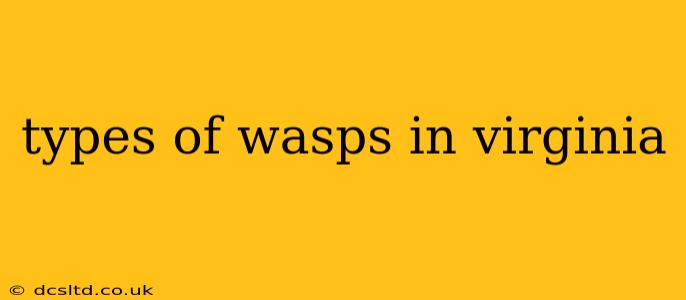Virginia, with its diverse ecosystems ranging from coastal plains to mountainous regions, is home to a wide variety of wasp species. Understanding the different types of wasps found in the state is crucial for safety and effective pest management. This guide explores common Virginia wasps, their characteristics, and how to differentiate them.
Common Wasp Types Found in Virginia
Many wasp species inhabit Virginia, but some are more prevalent than others. Let's delve into some of the most frequently encountered:
1. Paper Wasps:
These social wasps build their characteristic open-comb nests, often found under eaves, in sheds, or on tree branches. They are typically slender with long legs and a distinctive, noticeable waist. Paper wasps in Virginia are generally not aggressive unless their nest is disturbed. Several species exist, varying slightly in color and size.
2. Yellow Jackets:
Yellow jackets are highly social wasps known for their aggressive nature, especially when their nests are threatened. They are easily identifiable by their bright yellow and black banding. These wasps build nests underground, in wall voids, or other concealed locations. Their stings are painful and can cause allergic reactions in sensitive individuals. Several species of yellow jackets exist in the state.
3. Bald-Faced Hornets:
Often mistaken for yellow jackets, bald-faced hornets are actually a type of yellow jacket. However, they are larger and have a distinctive black and white pattern rather than yellow and black. They construct large, grayish-white paper nests, often high in trees or shrubs. Like yellow jackets, they are aggressive when their nests are disturbed.
4. Cicada Killers:
These large, solitary wasps are impressive in size. They are not aggressive towards humans unless directly handled. Their primary focus is hunting cicadas, which they paralyze and store to feed their larvae. They are often seen flying close to the ground, especially in areas with a high cicada population.
5. Mud Daubers:
These solitary wasps build their nests from mud, typically found in sheltered areas such as under eaves, in sheds, or on walls. They are slender, with long, thin waists. Mud daubers are generally not aggressive and rarely sting unless directly threatened. Different species exhibit variations in size and color.
Frequently Asked Questions (FAQs)
Here are some frequently asked questions about wasps in Virginia, addressing common concerns and providing helpful information:
What is the most dangerous wasp in Virginia?
While all wasp stings can be painful, yellow jackets are generally considered the most dangerous due to their aggressive nature and tendency to sting repeatedly. Their nests are often located near human activity, increasing the likelihood of encounters. Allergic reactions to stings pose the most significant risk.
How can I identify a wasp nest?
Wasp nests vary in appearance depending on the species. Paper wasps build open-comb nests, while yellow jackets and bald-faced hornets construct enclosed nests made of papery material. Cicada killers dig burrows in the ground, and mud daubers construct mud nests in various sheltered locations. Locating a nest is the first step in determining the type of wasp.
How can I prevent wasps from building nests near my home?
Preventing wasp nests involves eliminating potential nesting sites. Seal any cracks or openings in your home's exterior, remove debris and clutter around your property, and keep food and sugary drinks covered. Regularly inspect your property for existing nests, and consider contacting pest control professionals for larger or inaccessible nests.
What should I do if I'm stung by a wasp?
If stung by a wasp, immediately remove the stinger if present (unlike bees, wasps can sting multiple times). Clean the area with soap and water. Apply a cold compress to reduce swelling and pain. Monitor for allergic reactions such as difficulty breathing, swelling of the face or throat, or dizziness. Seek immediate medical attention if an allergic reaction occurs.
Are all wasps aggressive?
No, not all wasps are aggressive. Solitary wasps like cicada killers and mud daubers are generally docile and only sting when threatened. Social wasps, such as yellow jackets and paper wasps, are more likely to defend their nests aggressively.
This guide provides a general overview of common wasp types in Virginia. Always exercise caution when encountering wasps and consult with pest control professionals for assistance with nest removal or infestations. Remember, understanding the different wasp species and their behaviors is crucial for coexistence and safety.
